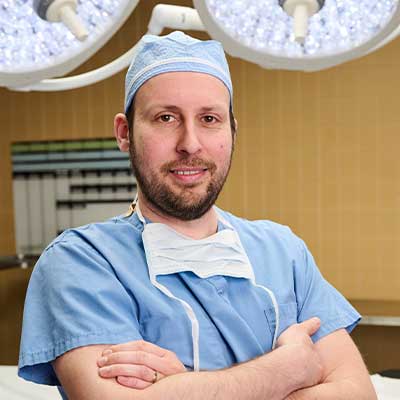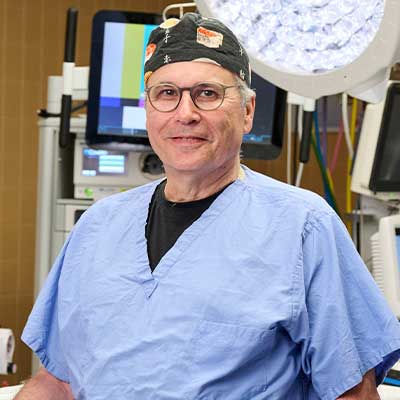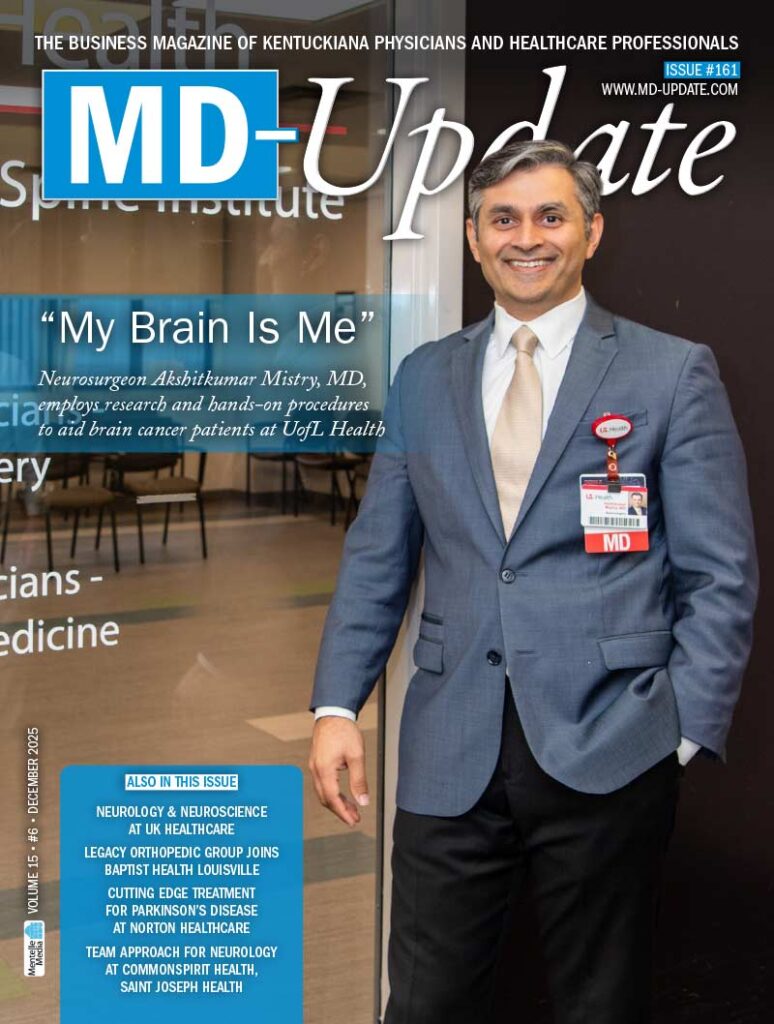Minimally invasive gynecological surgery at Norton Women’s Care is for more than fibroids and endometriosis
LOUISVILLE Advancements in minimally invasive gynecological surgery are changing the way patients and doctors perceive the procedure, say Jonathan Reinstine, MD, and Steven Radtke, MD.
Reinstine is the medical director at the Center of Excellence for Minimally Invasive Gynecology at Norton Women’s Care, where Radtke is a surgeon. Radtke is Reinstine’s successor, the two doctors say, and will ultimately take over the directorship.
Reinstine says that advances in the practice of minimally invasive gynecological surgery, or MIGS, are making the procedure more commonplace while expanding its use. Now applicable for more than just fibroids or endometriosis, the future of MIGS will help doctors treat more than just the gynecological aspects of pelvic pain.
Reinstine is a gynecologist with Associates in Obstetrics & Gynecology, part of Norton Women’s Care. After earning his medical degree from the University of Virginia in Charlottesville, he completed his residency at the University of Louisville where he is now a clinical professor in the school’s Department of Obstetrics, Gynecology and Women’s Health. He also serves as the associate director of fellowship in Minimally Invasive Gynecology.
Radtke earned his medical degree from Instituto Tecnológico y de Estudios Superiores de Monterrey, Mexico, and completed his OB/GYN residency at Southern Illinois University School of Medicine in Springfield. After completing his fellowship in MIGS at the University of Tennessee College of Medicine in Chattanooga, where he trained in advanced laparoscopic and robotic surgery, Radtke served as the chief of minimally invasive gynecological surgery at Texas Tech University Health and Sciences Center in El Paso before coming to Louisville and Norton Urogynecology Center.


Instrumentation Has Changed Surgery
Reinstine says “Over my 40 year career, MIGS has changed dramatically.”
“Back in the late 80s and early 90s, we were kind of winging it; we were creating it,” he says. “We didn’t have the instrumentation that we have now. Many of the surgical specialties now embrace minimally invasive surgery for what it is. The instrumentation is fantastic.”
Patient knowledge of the procedure has also changed. Now, he says, patients with pelvic pain may go to their doctors and request a minimally invasive approach. “We have been able to utilize laparoscopic, hysteroscopic, or robotically-assisted procedures.”
“Robotics for gynecology was introduced in about 2004 after it was FDA approved,” says Reinstine. “It is only one of the options we have, but it can bring some components to the table on certain cases such as for cancer and advanced endometriosis.”
MIGS provides care for what is a growing problem, says Radtke.
“Prior to fellowship, I practiced general OB/ GYN for a couple years, and during that time I identified that resources were limited when it came to managing chronic pelvic pain conditions, which is a huge issue,” says Radtke.
In Radtke’s experience, endometriosis is the culprit in about 70% of patients experiencing pelvic pain. “This condition is way more than just a nuisance,” he says. “It can completely impair a patient’s quality of life. Even though there has been great progress in developing new medications to treat endometriosis, these are not always effective. Also, we see patients that want to address the problem without being committed to taking prescription meds indefinitely.
“When we proceed with surgery, the first thing we get is an answer. Inspecting the inner lining of the pelvis allows us to spot any abnormal areas suggestive of endometriosis and corroborate our suspicion as to the source of the patient’s pain. In the past, it was thought that endometriosis could be treated by superficially burning the lesions. Now we know that excising them is significantly more effective in terms of resolving the patient’s pain and decreasing the risk of recurrence. Furthermore, we often find implants on critical areas such as the rectum, ureters, bladder, around major vessels, etc., which can’t be cauterized without injuring the underlying structure. This is where the specialty of MIGS comes in.”
MIGS practitioners are also trained to fully take advantage of new surgical technologies such as advanced laparoscopic instruments and robotic surgery.
“The mantra of the specialty is to solve a patient’s problem while minimizing the effect on surrounding tissues,” says Radtke. “For instance, markedly enlarged fibroid tumors that traditionally required a large abdominal incision to address can now be surgically managed via laparoscopy. This allows patients to return to normal life within a few days and markedly reduces long term risks such as infections, DVTs, hernias, scar tissue, etc. Most of our patients don’t even have to stay overnight in the hospital.”
Outcomes Can Exceed Expectations
Sometimes, Reinstine says, the results exceed expectations.
In one case, a patient who wanted to have children came to Reinstine with massively large fibroids. After extensive laparoscopic myomectomies, the patient did not get pregnant, he recalls. However, the patient opted to have a uterine artery embolization, a procedure not recommended for patients planning on getting pregnant.
After the procedure, while her symptoms improved, the patient experienced irregular periods. Reinstine says they discovered the patient was pregnant. After delivery through cesarean section, the doctor also discovered a fibroid inside of her uterus the size of the baby’s head.
After recovering from the cesarean section, she returned to Reinstine and asked for another fibroid embolization. Despite that procedure, the patient was able to get pregnant again and deliver another healthy baby.
“I think in a general sense for MIGS, patients are very relieved that a minimally invasive approach is possible for them. Thanks to recent advances, there is almost no situation where a problem cannot be solved via a minimally invasive technique,” says

Radtke. “And I think that patients after surgery are very pleased, because the pain profile is so much better than what they expected. When we see them for their two-week postop check, most patients will tell us they only needed pain medications for one or two days.”
Reinstine said doctors’ attitudes about pelvic pain, and recognizing that female pelvic pain isn’t limited to gynecological issues, is an advancement for the field.
“So often it is assumed that pelvic pain is gynecological, but there can be so much more: gynecological, urogynecological, gastroenterological, musculoskeletal, and neurological,” he says. “What we’re doing now is evaluating all sources. This idea that women come back every one or two years to have a touch-up surgery for endometriosis is something we really need to get away from. We really can do a lot more than we used to and we have to consider multi-modal treatment plans to cover all bases.”
Pelvic Pain Is Not Normal
Both doctors said there needs to be a shift in patients’ view of pain as a symptom as well, and not just another aspect of life.
“I think most physicians are pretty good at knowing that pelvic pain is not normal,” says Radtke. “When we talk to patients, the main message is that pelvic pain that is interfering with their quality of life is not normal. Being incapacitated for seven to ten days out of the month during a menstrual cycle is not normal. Luckily, there are options available to help with this.”
The future of MIGS, Reinstine says, lies in complex benign gynecology.
“One of the limitations for gynecologic surgeons is that we generally don’t operate on the bowel, and we generally don’t operate on the urinary tract. One of the reasons why the oncology surgeons will sometimes get tapped for benign cases is because they do operate on the urinary tract, and they do operate on the bowel,” he says. “At a national level, there’s a real push now for those of us in advanced benign gynecology to be able to do that. So complex benign gynecology, I think, will be the next phase of our fellowship, so that our trainees will be able, for example, to take care of rectal endometriosis. Or to be able to take care of invasive endometriosis into the bladder.”
The future will also be high-tech, Radtke says.
“One of the next things when it comes to surgery is augmented reality or AI. It’s not available yet, but it’s on the horizon,” Radtke says. “During laparoscopic or robotic surgery, the screen will have overlays that are assisting the surgeon, saying, ‘That area is highly suspicious for endometriosis,’ or ‘the appendix looks abnormal.’ It’ll basically be another set of virtual eyes to help surgeons not miss things.”
When there is innovation in MIGS, the surgeons at the Center of Excellence for Minimally Invasive Gynecology at Norton Women’s Care will be ready.



